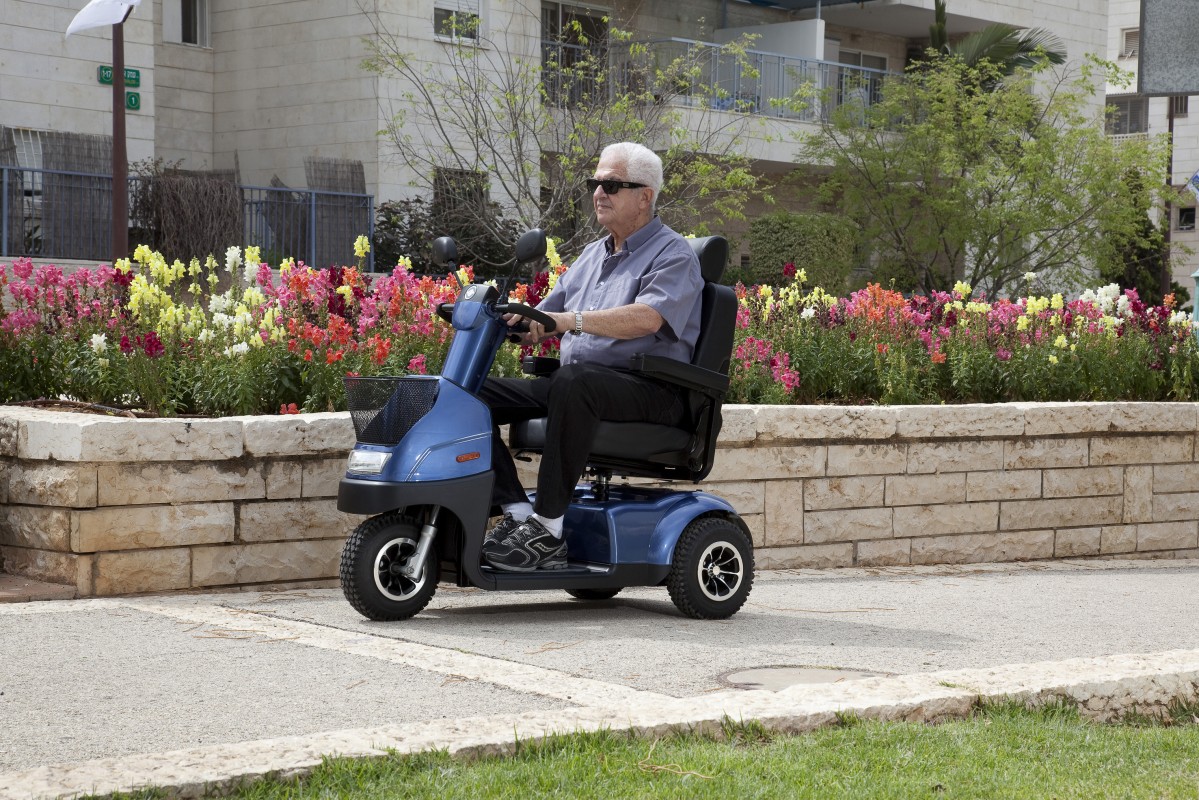Electric Mobility Scooter Buying Guide
Electric Mobility Scooter Buying Guide
A mobility scooter can help create new possibilities for individuals with physical disabilities that restrict their movement. This device features motor-powered wheels and a comfortable seat on a sleek chassis, providing an easy and stylish way to move around from one place to another. Mobility scooters incorporate a range of features so that they can accommodate different needs.
While the diversity of options is beneficial to those who need mobility scooters, selecting the right scooter can be a challenge. Buyers should be familiar with the different features that these devices offer in order to determine the specific features they can and cannot do without. It is also important that potential buyers be aware of the advantages and limitations of mobility scooters. While these devices meet a broad range of needs, they are not right for everyone. Lastly, buyers should also understand the local legislation regarding mobility scooters so that the devices are used responsibly. By learning all that they can about mobility scooters before making a purchase, buyers can successfully find the scooter that meets their needs.
Advantages and Limitations of Mobility Scooters:
Before purchasing a mobility scooter, a buyer should be aware of its advantages and drawbacks. This understanding not only helps buyers decide if mobility scooters are right for them, but it also provides insight into getting the most from the use of mobility scooters.
Advantages:
The main advantage of mobility scooters is that they help people with physical disabilities move from place to place and access areas that they would otherwise have trouble reaching. Wheelchairs provide the same benefits, but mobility scooters have advantages over wheelchairs in a few aspects. First, individuals lacking the stamina or arm capability to move a manual wheelchair can use the electric power of a mobility scooter for transportation. Second, mobility scooters tend to be less expensive than motorised wheelchairs. Third, the swivelling seat of a mobility scooter provides a freer range of movement than the foot supports on a wheelchair. These advantages are leading more and more people to use mobility scooters in order to cope with ambulatory difficulties.
Limitations:
Although mobility scooters afford numerous benefits to individuals with physical difficulties, there are also a few drawbacks that potential buyers should be aware of. Mobility scooters do require users to have a measure of mobility to get on and off them. They also require to users to sit with upright posture, and this may not be possible for some people. Wheelchairs tend to provide more attachments to aid body support than mobility scooters do. Furthermore, mobility scooters are longer than wheelchairs, giving them a greater turn radius and thereby limiting their use in smaller spaces. These limitations mean that mobility scooters may not be appropriate for everyone. It is therefore important that buyers ensure that mobility scooter limitations do not hamper one's ability to use these devices.
Types of Mobility Scooters and Associated Legalities:
Another important step in preparing to buy a mobility scooter is to become aware of the different types of mobility scooters and the legalities regarding the use of each type. Being familiar with these points can help buyers choose the right mobility scooters for their needs and use them properly after purchasing them.
Features in Mobility Scooters:
Once buyers are aware of the different classes of mobility scooters, they can consider the different features available in mobility scooters. There are numerous important features to pay attention to, and purchasing the right mobility scooter largely depends on choosing the features that ideally suit a buyer's needs.
Wheels:
Mobility scooters may have three, four, or five wheels. Two of the wheels are always rear wheels, and the rest are front wheels. Three wheels shorten the scooter's turn radius, giving the user more flexible mobility. Four wheels provide greater stability for the scooter, though three-wheel scooters may be outfitted with two additional stabilising wheels attached to the front wheel. These are five-wheel models.
Mobility scooters may also be front-wheel drive or rear-wheel drive. The former is generally a smaller scooter intended for indoor use with a rider-weight capacity of 115 kg. The latter is for either indoor or outdoor use and capable of carrying riders weighing up to 160 kg. Some heavy duty rear-wheel drive models have a weight capacity of 225 kg.
Controls:
The controls for most mobility scooters are located on the handlebars. Operators use their fingers and thumbs to control the scooters. The forward controls are generally on the right-hand side and the reverse controls on the left. Some mobility scooters have these controls reversed for left-handed users.
Seat:
A mobility scooter can feature either a small seat with a padded backrest or a larger seat with a backrest and a headrest. The former type is usually found on boot and mid-size scooters and the latter on scooters that are driven on roads. No matter the type of scooter, the seat usually swivels to help the user get on and off the scooter. Most seats are also adjustable for height, and some can slide forward and backward. Larger seats may also offer adjustable backrest angles and headrest heights.
Tiller:
The tiller is the front column of a mobility scooter. The handlebars and controls are part of the tiller, and its angle is usually adjustable. The adjustment mechanism may be slots or flexible teeth. Buyers should be aware that some smaller, portable scooters do not have an adjustable tiller. They should therefore try to ascertain if the fixed position can work for them.
Batteries:
Mobility scooters use 12-volt batteries to power their motors. The runtime of a mobility scooter depends on the size of its batteries, and this is reflected in amp hours. The low end of the amp-hour range for mobility scooters is 12Ah and the upper end 75Ah. A large luxury scooter is likely outfitted with large batteries that make it capable of running for 20 hours before needing to be recharged.
Brakes:
All mobility scooters feature brakes. The brake remains on until the scooter is put into drive. As soon as the user lets go of the drive control, the brake re-engages. The mobility scooter also has a lever that basically puts the scooter into neutral so that the user can push it if need be. Some larger scooters also incorporate an emergency brake that stops the rear wheels in the rare case that the main braking system fails.
Size:
Size is a very important feature for mobility scooters. Some buyers may prefer to be able to put the mobility scooter in a car while others need scooters for road use. Buyers should therefore be familiar with the different size standards for mobility scooters.
Boot Scooters:
Boot scooters are so named because they fit into the boot of most cars, and they are light and portable. Their small size means that they have small batteries and are thus limited to a 16-km range. Boot scooters also have lower weight-bearing capabilities, smaller seats, and less shock absorption than larger, less portable mobility scooters.
Mid-Size Scooters:
Mid-size scooters strike a good balance between portability and the other features that buyers may seek in mobility scooters. They have ranges up to 40 km and can carry more weight than boot scooters. Mid-size scooters also provide a relatively stable ride and are capable of climbing kerbs. Some may be dismantled for transportation, though this is not practical on a frequent basis.
Town and Country Scooters:
Town and Country mobility scooters are large and, therefore, not very portable. However, what they sacrifice in portability, they make up for in other features. Town and Country scooters generally have high load-bearing capacities, are capable of speeds up to 12.8 km/h, and absorb shock very well. They also feature comfortable seats with a number of adjustment options. Town and Country scooters are not necessarily designed for portability, but they are ideal for heavy use.
Mobility Scooter Sales:
Contact Accessible Madrid (www.accessiblemadrid.com) if you need further and detailed information on mobility scooters. If you travel to Spain, specially to Madrid Hire an electric scooter at Accessible Madrid . This company offers home delivery service for electric scooter rentals in Madrid. If you are a disabled traveler, and you will be visiting Madrid, Madrid contact Accessible Madrid (www.accessiblemadrid.com). We are happy to help you with your accessible holidays in Madrid. Try our wide range of accessible services (transfers adapted van, accessible tours in Madrid, etc). We also offer accessible tours and excursions to Toledo, Segovia, El Escorial, Aranjuez, etc, always departing from Madrid.
We hope you find these tips helpful. Accessible Madrid offers a professional and specialized service on electric mobility scooters sales
Conclusion:
A mobility scooter can be a very rewarding purchase, giving its owner the ability to access places that he or she previously could not. As beneficial as these devices can be, purchasing the right scooter can also be a challenge. Potential buyers have to consider the advantages and limitations of mobility scooters before making a purchase. Once a decision to purchase a mobility scooter is made, the buyer must gain an understanding of the different classifications for these devices. Factors to take into account when making a purchase include different features such as the wheels, controls, seat, tiller, batteries, brakes, and size.


